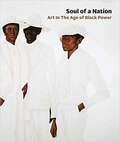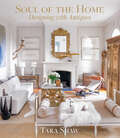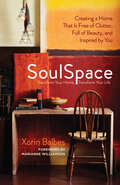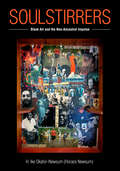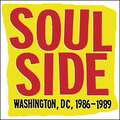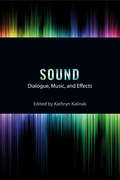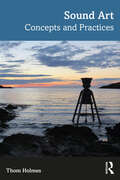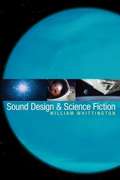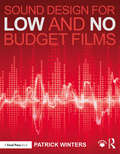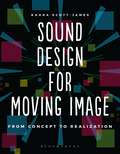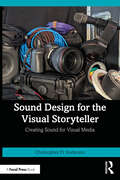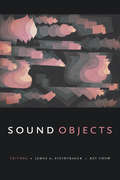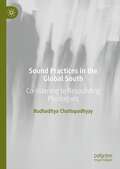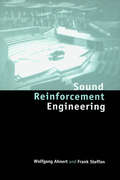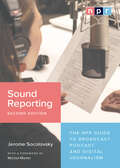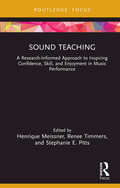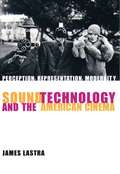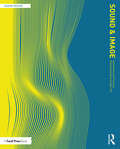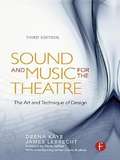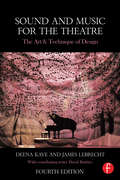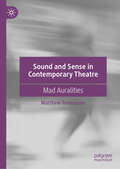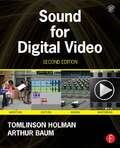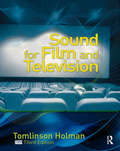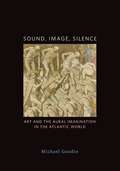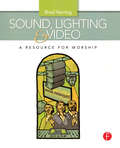- Table View
- List View
Soul of a Nation: Art in the Age of Black Power
by Mark Godfrey Linda Goode Bryant Zoé WhitleyAfrican American art in the era of Malcolm X and the Black Panthers <p><p> In the period of radical change that was 1963–83, young black artists at the beginning of their careers confronted difficult questions about art, politics and racial identity. How to make art that would stand as innovative, original, formally and materially complex, while also making work that reflected their concerns and experience as black Americans? <p><p> Soul of a Nation surveys this crucial period in American art history, bringing to light previously neglected histories of 20th-century black artists, including Sam Gilliam, Melvin Edwards, Jack Whitten, William T. Williams, Howardina Pindell, Romare Bearden, David Hammons, Barkley L. Hendricks, Senga Nengudi, Noah Purifoy, Faith Ringgold, Betye Saar, Charles White and Frank Bowling. <p><p> The book features substantial essays from Mark Godfrey and Zoe Whitley, writing on abstraction and figuration, respectively. It also explores the art-historical and social contexts with subjects ranging from black feminism, AfriCOBRA and other artist-run groups to the role of museums in the debates of the period and visual art’s relation to the Black Arts Movement. Over 170 artworks by these and many other artists of the era are illustrated in full color. <p><p> 2017 marks the 50th anniversary of the first use of the term “black power” by student activist Stokely Carmichael; it will also be 50 years since the US Supreme Court overturned the prohibition of interracial marriage. At this turning point in the reassessment of African American art history, Soul of a Nation is a vital contribution to this timely subject.
Soul of the Home: Designing with Antiques
by Tara ShawPast meets present in this stylish guide to decorating modern homes with heirlooms and antiques. Designer and antiques dealer Tara Shaw is a respected supplier of French and European antiques for a host of AD100 and Elle Decor A-listers, including Bobby McAlpine, Mary McDonald, and Bunny Williams. In her first book, she helps readers understand how to select the best antiques and how to use them in a variety of decor schemes. The book presents never-before-published spaces from Shaw’s portfolio and reveals her favorite antique-hunting spots throughout Europe. Anecdotes from years of treasure hunting are accompanied by images of rare and precious finds, with text that decodes just how to choose the right pieces and display them in a contemporary interior. Readers will be able to look at each space and take away ideas they can apply to their own homes, to create personalized rooms full of provenance and beauty.
SoulSpace: Transform Your Home, Transform Your Life -- Creating a Home That Is Free of Clutter, Full of Beauty, and Inspired by You
by Xorin BalbesExpertly designed and decorated homes don’t necessarily feel like havens to their dwellers or reflect, inspire, and celebrate what is essential about their inhabitants. Lauded designer and architectural conservator Xorin Balbes created the eight-stage SoulSpace transformation process to help his clients do just that. Through the stages — assess, release, cleanse, dream, discover, create, elevate, and celebrate — readers explore not only the design of their living spaces but also their own interiors: the ways they think, feel, and sense. Through client stories, exercises, Q & As, and bountiful photos and illustrations, Balbes guides readers to decode clues to what they wish for, deny, and need to move forward. Empowered with this self-knowledge, they are free to declutter, refresh, and enhance their living spaces. Suitable for any budget and for one wall or one room, apartments or mansions, Balbes’s wonderfully unique technique nurtures and transforms both souls and their spaces.
SoulStirrers: Black Art and the Neo-Ancestral Impulse
by H. Ike Okafor-NewsumIn SoulStirrers, H. Ike Okafor-Newsum describes the birth and development of an artistic movement in Cincinnati, Ohio, identified with the Neo-Ancestral impulse. The Neo-Ancestral impulse emerges as an extension of the Harlem Renaissance, the Negritude Movement, and the Black Arts Movement, all of which sought to re-represent the "primitive" and "savage" black and African in new terms. Central to the dominant racial framework has always been the conception that the black subject was not only inferior, but indeed incapable of producing art. The Neo-Ancestral impulse posed a challenge to both existing form and content. Like its intellectual antecedents, the movement did not separate art from life and raised a central question, one that the "soul stirrers" of Cincinnati are engaging in their artistic productions. Okafor-Newsum defines collapsing of the sacred and the profane as a central tendency of African aesthetics, transformed and rearticulated here in the Americas.In this volume, the artistic productions ask readers to consider the role of those creating and viewing this art by attempting to shift the way in which we view the ordinary. The works of these artists, therefore, are not only about the survival of African-derived cultural forms, though such remains a central effect of them. These extraordinary pieces, installations, and movements consistently refer to the cultural reality of the Americas and the need for political and intellectual transformation. They constitute important intellectual interventions that serve as indispensable elements in the redefinition and reinterpretation of our society.Featuring numerous color illustrations and profiles of artists, this volume reveals exciting trends in African American art and in the African diaspora more broadly.
Soulside: Washington, Dc, 1986-1989
by Alexis FleisigA photographic history of the DC-based 1980s punk rock band that recorded for Dischord Records. "If you know and love the band, this is a must, if you like DC punk bands, also." --Trust (Germany) Soulside, a band from the mid-1980s Dischord Records punk rock scene in Washington, DC, grew into maturity in a few short years, goin
Sound
by Jeff Smith Mark Kerins James Wierzbicki Vanessa Theme Ament Kathryn Kalinak Nathan Platte Jay BeckSound has always been an integral component of the moviegoing experience. Even during the so-called "silent era," motion pictures were regularly accompanied by live music, lectures, and sound effects. Today, whether we listen to movies in booming Dolby theaters or on tiny laptop speakers, sonic elements hold our attention and guide our emotional responses. Yet few of us are fully aware of the tremendous collaborative work, involving both artistry and technical wizardry, required to create that cinematic soundscape. Sound, the latest book in the Behind the Silver Screen series, introduces key concepts, seminal moments, and pivotal figures in the development of cinematic sound. Each of the book's six chapters cover a different era in the history of Hollywood, from silent films to the digital age, and each is written by an expert in that period. Together, the book's contributors are able to explore a remarkable range of past and present film industry practices, from the hiring of elocution coaches to the marketing of soundtrack records. Not only does the collection highlight the achievements of renowned sound designers and film composers like Ben Burtt and John Williams, it also honors the unsung workers whose inventions, artistry, and performances have shaped the soundscapes of many notable movies. After you read Sound, you'll never see--or hear--movies in quite the same way. Sound is a volume in the Behind the Silver Screen series--other titles in the series include Acting; Animation; Art Direction and Production Design; Cinematography; Costume, Makeup, and Hair; Directing; Editing and Special Visual Effects; Producing; and Screenwriting.
Sound Art: Concepts and Practices
by Thom HolmesSound Art offers the first comprehensive introduction to sound art written for undergraduate students. Bridging and blending aspects of the visual and sonic arts, modern sound art first emerged in the early 20th century and has grown into a thriving and varied field. In 13 thematic chapters, this book enables students to clearly grasp both the concepts behind this unique area of art, and its history and practice. Each chapter begins with an exploration of key ideas and theories, followed by an in-depth discussion of selected relevant works, both classic and current. Drawing on a broad, diverse range of examples, and firmly interdisciplinary, this book will be essential reading for anyone studying or teaching the theory, history, appreciation, or practice of sound art.
Sound Design and Sound Fiction
by William WhittingtonSound is half the picture, and since the 1960s, film sound not only has rivaled the innovative imagery of contemporary Hollywood cinema, but in some ways has surpassed it in status and privilege because of the emergence of sound design. This in-depth study by William Whittington considers the evolution of sound design not only through cultural and technological developments during the last four decades, but also through the attitudes and expectations of filmgoers. Fans of recent blockbuster films, in particular science fiction films, have come to expect a more advanced and refined degree of film sound use, which has changed the way they experience and understand spectacle and storytelling in contemporary cinema. The book covers recent science fiction cinema in rich and compelling detail, providing a new sounding of familiar films, while offering insights into the constructed nature of cinematic sound design. This is accomplished by examining the formal elements and historical context of sound production in movies to better appreciate how a film sound track is conceived and presented. Whittington focuses on seminal science fiction films that have made specific advances in film sound, including 2001: A Space Odyssey, THX 1138, Star Wars, Alien, Blade Runner (original version and director's cut), Terminator 2: Judgment Day and The Matrix trilogy and games--milestones of the entertainment industry's technological and aesthetic advancements with sound. Setting itself apart from other works, the book illustrates through accessible detail and compelling examples how swiftly such advancements in film sound aesthetics and technology have influenced recent science fiction cinema, and examines how these changes correlate to the history, theory, and practice of contemporary Hollywood filmmaking.
Sound Design for Low & No Budget Films
by Patrick WintersDon’t let your indie film be sabotaged by bad sound! One of the weakest technical aspects of a low or no budget short or feature film is usually the sound, and in Sound Design for Low and No Budget Films, author Patrick Winters explains what filmmakers need to do to fix that. Learn how to improve the sound quality of your low budget film with specific tools and practices for achieving a better sound track, including detailed, step-by-step explanations of how to edit your production track, create a sound design, record and edit ADR, Foley and sound effects, music, and much more. Focusing on the essential details indie filmmakers need to know, Winters teaches you how to turn a thin and distracting sound track into one that makes your film shine. This practical guide offers: • In-depth focus on hands-on, step-by-step instruction for achieving great sound in post-production, including recording and editing sound effects, ADR and Foley—even without expensive equipment and software. • Techniques specifically designed for low and no budget projects, perfect for both students and aspiring indie filmmakers. • A simple and direct style that any aspiring filmmaker or student can understand without already knowing the industry jargon.
Sound Design for Moving Image: From Concept to Realization
by Kahra Scott-JamesThis book offers a clear introduction to sound design theory and practice to help you integrate sound ideas into your productions. Contemporary soundtracks are often made up of hundreds of separate tracks, and thousands of individual sounds, including elements of dialogue, music and sound effects. As a result, many budding filmmakers find them a daunting prospect, and are tempted to leave sound to the last stages of post-production. <p><p> This book, from award-winning Sound Designer Kahra Scott-James, encourages you to incorporate sound into your pre-production planning, to make the most of this powerful narrative tool. Adopting a specific framework in order to help demystify sound design for moving image, the book isn't designed as a sound engineering handbook, but as a guide for moving image content creators wanting to explore sound and collaborate with sound designers. <p><p> Regardless of medium, the same, or similar concepts can be adopted, adapted, and applied to any project employing sound. Includes detailed and insightful interviews with leading sound designers, including Randy Thom, Director of Sound Design at Skywalker Sound, and Glenn Kiser, Director of the Dolby Institute, as well as practical projects to help you hone your skills using video and sound files available from the companion website - https://bloomsbury.com/cw/sound-design-for-moving-image - making this is a complete sound course to take you from novice skills to confident practitioner.
Sound Design for the Visual Storyteller: Creating Sound for Visual Media
by Christopher D. AndersonSound Design for the Visual Storyteller is an overview of the sound design process for the beginner filmmaker or storyteller, providing the foundational knowledge needed to succeed at utilizing and designing sound for visual stories, films, and even podcasts.With a focus on television and film, alongside references to podcast, theatre, event, and game sound design, this all-in-one overview begins with the fundamentals of sound and the structure of a professional sound design team, before exploring the practical topics of post-production, creative workflows, and distribution. Supported by a plethora of audio and video examples to demonstrate key concepts, this book guides aspiring sound designers on the power and production value of the well-conceived soundtrack and showcases some of the most effective techniques for getting there.This is an ideal introduction for storytellers working in a range of contexts, including filmmakers, sound designers, and sound editors, as well as students of sound for film and broadcast.
Sound Objects
by Rey Chow James A. SteintragerIs a sound an object, an experience, an event, or a relation? What exactly does the emerging discipline of sound studies study? Sound Objects pursues these questions while exploring how history, culture, and mediation entwine with sound’s elusive objectivity. Examining the genealogy and evolution of the concept of the sound object, the commodification of sound, acousmatic listening, nonhuman sounds, and sound and memory, the contributors not only probe conceptual issues that lie in the forefront of contemporary sonic discussions but also underscore auditory experience as fundamental to sound as a critical enterprise. In so doing, they offer exciting considerations of sound within and beyond its role in meaning, communication, and information and an illuminatingly original theoretical overview of the field of sound studies itself. Contributors. Georgina Born, Michael Bull, Michel Chion, Rey Chow, John Dack, Veit Erlmann, Brian Kane, Jairo Moreno, John Mowitt, Pooja Rangan, Gavin Steingo, James A. Steintrager, Jonathan Sterne, David Toop
Sound Practices in the Global South: Co-listening to Resounding Plurilogues
by Budhaditya ChattopadhyayThis book develops a comprehensive understanding of the unique sound worlds of key regions in the Global South, through an auto-ethnographic method of self-reflective conversations with prominent sound practitioners from South Asia, Africa, the Middle East and Latin America. The conversations navigate various trajectories of sound practices, illuminating intricate sonic processes of listening, thinking through sounds, ideating, exposing, and performing with sound. This collection of conversations constitutes the main body of the book, including critical and scholarly commentaries on aural cultures, sound theory and production. The book builds a ground-up approach to nurturing knowledge about aural cultures and sonic aesthetics, moving beyond the Eurocentric focus of contemporary sound studies. Instead of understanding sound practices through consumption and entertainment, they are explored as complex cultural and aesthetic systems, working directly with the practitioners themselves, who largely contribute to the development of the sonic methodologies. Refocusing on the working methods of practitioners, the book reveals a tension between the West’s predominant colonial-consumerist cultures, and the collective desires of practitioners to resist colonial models of listening by expressing themselves in terms of their arts and craft, and their critical faculties.Conversations with: Clarence Barlow, Sandeep Bhagwati, Rajesh K. Mehta, Sharif Sehnaoui, Ximena Alarcón Díaz, Hardi Kurda, Mario de Vega, Luka Mukhavele, Khyam Allami, Cedrik Fermont, Khaled Kaddal, David Velez, Juan Duarte, Youmna Saba, Abdellah M. Hassak, Mariana Marcassa, Amanda Gutiérrez, Syma Tariq, Alma Laprida, Siamak Anvari, Mohamad Safa, Debashis Sinha, Zouheir Atbane, Constanza Bizraelli, Jatin Vidyarthi, Joseph Kamaru, Surabhi Saraf, Isuru Kumarasinghe, Hemant Sreekumar.
Sound Reinforcement Engineering: Fundamentals and Practice
by Wolfgang Ahnert Frank SteffenSound reinforcement is the increasing of the power of sound signals and reproducing them as acoustic signals. This book gives an introduction to the fundamentals of sound reinforcement engineering, and also explains how it relates to disciplines such as room acoustics. It discusses in detail the components and layout of sound reinforcement systems and gives examples and case studies of successfully installed systems.
Sound Reporting, Second Edition: The NPR Guide to Broadcast, Podcast and Digital Journalism
by Jerome SocolovskyAn indispensable guide to audio journalism grounded in NPR’s journalistic values and practices, with tips and insights from its top reporters, hosts, editors, producers, and more. A lot has changed in media in recent years, but one thing that remains steadfast is National Public Radio’s (NPR) position as a trusted source of news in the United States. Now producing dozens of shows and podcasts, plus livestreams and coverage on other media platforms, NPR is the leading authority on reporting, writing, and delivering audio news and storytelling to today's diverse audiences. In this completely revised guide, audio journalism trainer Jerome Socolovsky offers a look into just how NPR does it, following the same journey a story would from idea to the moment it reaches its listeners. Based on more than eighty interviews with producers, reporters, editors, hosts, and other NPR staffers, Sound Reporting reveals how stories get pitched; how they are reported, produced, written, edited, voiced, and tailored to multiple media formats; and how shows and podcasts are put together. It begins with a presentation of NPR's values and includes a new chapter on journalist safety, a topic of timely importance. Podcasts, now part of the mainstream of the media universe, are treated alongside traditional programs throughout. In these pages, the voices of NPR staff offer a glimpse into their profession. Discover how correspondent Ruth Sherlock overcame seemingly insurmountable odds as she raced to the scene of a devastating earthquake in Turkey, the four main ways Ramtin Arablouei incorporates music into podcasts, and how “Weekend Edition” host Ayesha Rascoe touches listeners so deeply she received a pair of homemade potholders in the mail from one of them. Reading this book is like sitting in a room full of top-notch producers, seasoned correspondents, trusted hosts, and rigorous editors—all telling you inspiring stories about their craft to help you learn from their experience. At a time when the legitimacy and authority of journalism are under critique, transparency into how the news is made is more important than ever. This book offers a fascinating look behind the scenes at a premier public media organization and will be a trusted resource for anyone in or exploring a future in audio journalism.
Sound Teaching: A Research-Informed Approach to Inspiring Confidence, Skill, and Enjoyment in Music Performance
by Renee Timmers Stephanie E. Pitts Henrique MeissnerSound Teaching explores the ways in which music psychology and education can meet to inspire developments in the teaching and learning of music performance. The book is based on music practitioners’ research into aspects of their own professional practice. Each chapter addresses a specific topic related to musical communication and expression, performance confidence and enjoyment, or skill development in individual and group learning. It explains the background of the research, outlines main findings, and provides suggestions for practical applications. Sound Teaching provides a research-informed approach to teaching and contributes to music tutors’ professional development in teaching children and adults of various ages and abilities. Sound Teaching is written for vocal and instrumental music teachers, music performers with a portfolio career, and music students at conservatoires and universities. Music students undertaking practice-related research will find examples of research methodologies and projects that are informative for their studies. Musical participants of all kinds – students, teachers, performers, and audiences – will find new ways of understanding their practice and experience through research.
Sound Technology and the American Cinema: Perception, Representation, Modernity (Film and Culture Series)
by James LastraRepresentational technologies including photography, phonography, and the cinema have helped define modernity itself. Since the nineteenth century, these technologies have challenged our trust of sensory perception, given the ephemeral unprecedented parity with the eternal, and created profound temporal and spatial displacements. But current approaches to representational and cultural history often neglect to examine these technologies. James Lastra seeks to remedy this neglect.Lastra argues that we are nowhere better able to track the relations between capital, science, and cultural practice than in photography, phonography, and the cinema. In particular, he maps the development of sound recording from its emergence to its confrontation with and integration into the Hollywood film.Reaching back into the late eighteenth century, to natural philosophy, stenography, automata, and human physiology, Lastra follows the shifting relationships between our senses, technology, and representation.
Sound and Image: Aesthetics and Practices (Sound Design)
by Andrew Knight-HillSound and Image: Aesthetics and Practices brings together international artist scholars to explore diverse sound and image practices, applying critical perspectives to interrogate and evaluate both the aesthetics and practices that underpin the audiovisual. Contributions draw upon established discourses in electroacoustic music, media art history, film studies, critical theory and dance; framing and critiquing these arguments within the context of diverse audiovisual practices. The volume’s interdisciplinary perspective contributes to the rich and evolving dialogue surrounding the audiovisual, demonstrating the value and significance of practice-informed theory, and theory derived from practice. The ideas and approaches explored within this book will find application in a wide range of contexts across the whole scope of audiovisuality, from visual music and experimental film, to narrative film and documentary, to live performance, sound design and into sonic art and electroacoustic music. This book is ideal for artists, composers and researchers investigating theoretical positions and compositional practices which bring together sound and image.
Sound and Music for the Theatre
by Deena Kaye James LebrechtThe same loved book you've been using for years - now including everything you need to know about sound design for the theatre. This edition still focuses on aesthetics of sound design for the stage along with design approaches and techniques. You'll still get the in-depth discussion with leading sound designers and composers to see how the experts get the job done.BUT, this new third edition has swept out the old to bring you the new! Now included is all of the latest technical information that you will need including:*Information about Digital Audio Workstations as everyday tools for sound effects*Maximizing the Internet and computer as a major, important, every day tool for today's sound designers and also composer? as a 24-hour library*new roundtable forum discussion with sound reinforcement designers that uncovers the way they make and communicate aesthetic decision*A fresh look at technology used to build and execute shows (digital audio workstations, software, and your computer as creative management tool)*Everyday paperwork'new examples for sound plots and queue sheets to increase the variety of examples and so you can pick your best fit
Sound and Music for the Theatre: The Art & Technique of Design
by Deena Kaye James LebrechtCovering every phase of a theatrical production, this fourth edition of Sound and Music for the Theatre traces the process of sound design from initial concept through implementation in actual performances. The book discusses the early evolution of sound design and how it supports the play, from researching sources for music and effects, to negotiating a contract. It shows you how to organize the construction of the sound design elements, how the designer functions in a rehearsal, and how to set up and train an operator to run sound equipment. This instructive information is interspersed with 'war stores' describing real-life problems with solutions that you can apply in your own work, whether you're a sound designer, composer, or sound operator.
Sound and Sense in Contemporary Theatre: Mad Auralities
by Matthew TomkinsonThis book is among the first to consider the subject of mad auralities in theatre and performance, asking: what does it mean to hear and listen madly? Drawing widely upon mad studies, critical disability studies, theatre studies, sound studies, queer studies, and critical race theory, it seeks to explore the theatrical relationship between sound and mental health differences by examining a range of case studies in which audience members are immersed in auditory simulations of madness. Ultimately, however, this critical study investigates the shortcomings of simulation as a representational practice, in keeping with the critical tradition of disability studies and mad studies.
Sound for Digital Video
by Arthur Baum Tomlinson HolmanAchieve professional quality sound on a limited budget! Harness all new, Hollywood style audio techniques to bring your independent film and video productions to the next level. In Sound for Digital Video, Second Edition industry experts Tomlinson Holman and Arthur Baum give you the tools and knowledge to apply recent advances in audio capture, video recording, editing workflow, and mixing to your own film or video with stunning results. This fresh edition is chockfull of techniques, tricks, and workflow secrets that you can apply to your own projects from preproduction through postproduction. New to this edition: A new feature on "true" 24p shooting and editing systems, as well as single vs. double-system recording A strong focus on new media, including mini-DVDs, hard disks, memory cards, and standard and high-definition imagery Discussion of camera selection, manual level control, camera and recorder inputs, location scouting, and preproduction planning Instruction in connectors, real-time transfers, and file-based transfers from DVDs, hard drives, and solid state media. Blu-Ray and HD tape formats for mastering and distribution in addition to file-based, DV, and DVD masters. A revamped companion website, www.focalpress.com/cw/holman, featuring recording and editing exercises, examples and sample tracks Whether you are an amateur filmmaker who wants to create great sound or an advanced professional in need of a reference guide, Sound for Digital Video, Second Edition is an essential addition to your digital audio tool belt.
Sound for Film and Television
by Tomlinson HolmanSound for Film and Television, Third Edition provides a thorough introduction to the fascinating field of recording, editing, mixing, and exhibiting film and television sound. It strikes a fine balance between aesthetic and technical content, combining theory and practice to approach sound as both an art and a science. This new edition has been completely updated to reflect the latest advances in HD technology, new hardware and software systems, new distribution methods, wireless sound capture, and more. Also, analog-related content has been reduced and transferred to the chapters covering historical techniques. Sections on troubleshooting and FAQs have been added to help you avoid common pitfalls in sound production. Written by one of Hollywood's leading sound experts, Sound for Film and Television provides a solid grounding in all aspects of the sound process. Basic principles are presented with illustrations demonstrating how they affect the day-to-day activities on a film or television set, in the editing room, and in the mix room. The accompanying audio DVD contains more than 50 tracks that demonstrate practical, real-world examples of key concepts presented in the book. A companion Web site provides further resources and information: http://booksite.focalpress.com/companion/Holman/SoundforFilmandTelevision/ Please use the access code located in the beginning of the book to register for access to the Web site.
Sound, Image, Silence: Art and the Aural Imagination in the Atlantic World
by Michael GaudioA visionary new approach to the Americas during the age of colonization, made by engaging with the aural aspects of supposedly &“silent&” images Colonial depictions of the North and South American landscape and its indigenous inhabitants fundamentally transformed the European imagination—but how did those images reach Europe, and how did they make their impact? In Sound, Image, Silence, noted art historian Michael Gaudio provides a groundbreaking examination of the colonial Americas by exploring the special role that aural imagination played in visible representations of the New World.Considering a diverse body of images that cover four hundred years of Atlantic history, Sound, Image, Silence addresses an important need within art history: to give hearing its due as a sense that can inform our understanding of images. Gaudio locates the noise of the pagan dance, the discord of battle, the din of revivalist religion, and the sublime sounds of nature in the Americas, such as lightning, thunder, and the waterfall. He invites readers to listen to visual media that seem deceptively couched in silence, offering bold new ideas on how art historians can engage with sound in inherently &“mute&” media.Sound, Image, Silence includes readings of Brazilian landscapes by the Dutch painter Frans Post, a London portrait of Benjamin Franklin, Thomas Edison&’s early Kinetoscope film Sioux Ghost Dance, and the work of Thomas Cole, founder of the Hudson River School of American landscape painting. It masterfully fuses a diversity of work across vast social, cultural, and spatial distances, giving us both a new way of understanding sound in art and a powerful new vision of the New World.
Sound, Lighting and Video: A Resource for Worship
by Brad HerringLights, Camera,Worship! is a manual for all of your technical needs. To draw people into your church with incredible worship experiences, you need to learn more about how to get the most from your lighting, sound, video, and projection systems. This is your one stop resource!Written by an experienced professional and consultant, this book will show you how to successfully run the major components that, done correctly, will make your church presentation the absolute best it can be and will draw more people in! This is packed with information that will not only show you how to use the technology, but how to troubleshoot and problem-solve in the areas you need it most from running a new control board to uniting your lighting and audio visual systems as one integrated unit. This won't just show you how to operate your systems - it will make your production go from OK to WOW!
